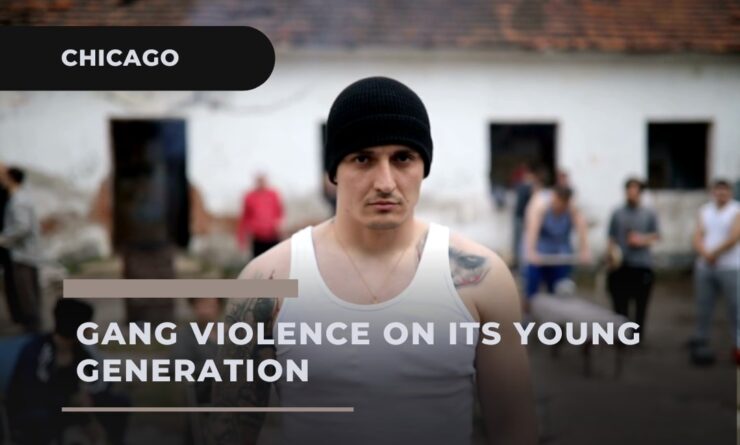Gang violence is a pervasive issue that has been plaguing Chicago for decades. It’s a complex problem that affects not just the individuals involved, but also the communities they live in, and most distressingly, the city’s youth. Understanding the impact of gang violence on Chicago’s youth is crucial in addressing the problem and finding effective solutions.
Chicago, often referred to as “Chiraq” due to its high violence rates, has been battling the issue of gang violence for years. The city’s youth, in particular, bear the brunt of this violence, with many of them falling victim to it or being drawn into the cycle of violence themselves. This article aims to shed light on the impact of violence on Chicago’s youth and explore potential solutions to this pressing issue.
The city’s struggle with gang violence is not a recent phenomenon. It has deep roots in the city’s history, and its impact on the youth is profound and far-reaching. From physical harm and psychological trauma to educational setbacks and bleak future prospects, the effects of gang violence on Chicago’s youth are multifaceted and deeply concerning.
The History of Gang Violence in Chicago
In Chicago has a long and complex history. It began in the late 19th century with ethnic street gangs, evolved during the Prohibition era with the rise of organized crime, and transformed in the late 20th century into a network of street gangs involved in drug trafficking and violent crime. The factors that have contributed to its prevalence include socioeconomic disparities, racial segregation, and systemic failures in education and law enforcement.
The evolution of violence in Chicago is closely tied to the city’s socio-economic and racial dynamics. The Great Migration of African Americans from the South to the North in the early 20th century led to a significant demographic shift in the city. This, coupled with economic decline and racial segregation, created fertile ground for the growth of street gangs. Over the years, these gangs have become more organized and violent, with their activities extending beyond the city’s borders.
The Prevalence of Gang Violence in Chicago
| Year | Homicides |
|---|---|
| 2018 | 561 |
| 2019 | 495 |
| 2020 | 769 |
| 2021 | 797 |
| 2022 | 803 |
Violence is a significant problem in Chicago, with the city often ranking high in terms of violent crime rates among major U.S. cities. According to the Chicago Police Department, the city recorded 769 homicides in 2020, a significant increase from the 495 recorded in 2019. The majority of these homicides were gang-related, highlighting the severity of the violence problem in the city.
When compared to other cities, Chicago’s gang violence problem stands out. According to a report by the National Gang Center, Chicago has one of the highest numbers of members per capita among major U.S. cities. The city’s problem is not just about the number of gangs or members, but also about the level of violence associated with these gangs.
Physical Harm
The physical harm caused by violence is perhaps the most visible and immediate impact on Chicago’s youth. According to a report by the Chicago Tribune, in 2018 alone, 561 homicides were recorded in the city, many of which were gang-related. These numbers are not just statistics; they represent young lives cut short, dreams unfulfilled, and families left to grieve.
The physical dangers faced by youth in areas with high gang activity are immense. They live in constant fear of being caught in the crossfire of gang wars, of being targeted for refusing to join a gang, or of being mistaken for a rival member. These fears are not unfounded. According to the Chicago Police Department, a significant proportion of the city’s homicides are gang-related.
The personal stories and case studies of young victims of violence are heart-wrenching. They tell tales of promising lives cut short, of dreams shattered, and of families left to pick up the pieces. These stories serve as a stark reminder of the human cost of violence and underscore the urgent need for effective solutions.
Psychological Trauma
The psychological impact of gang violence on Chicago’s youth is profound and often overlooked. Living in areas with high activity can lead to chronic stress, anxiety, and post-traumatic stress disorder (PTSD). According to a study published in the Journal of Adolescent Health, exposure to violence can lead to symptoms of PTSD in children and adolescents, affecting their mental health and overall well-being.In a recent display of courage, a local resident’s intervention during an assault in West Town exemplifies the critical role of community action in these harrowing situations.
The psychological effects of living in areas with high gang activity extend beyond the immediate fear and stress. They can also lead to feelings of hopelessness and despair, affecting young people’s self-esteem and sense of self-worth. This can have a detrimental effect on their mental health, leading to depression and other mental health disorders.
The long-term mental health implications for these youth are significant. According to the National Institute of Mental Health, exposure to violence in childhood can lead to a range of mental health issues in adulthood, including depression, anxiety, and substance abuse disorders. This underscores the urgent need for mental health support and intervention for youth exposed to violence.
Impact On Education
Also has a significant impact on the educational opportunities and outcomes for Chicago’s youth. Schools in areas with high gang activity often struggle with issues such as low attendance, high dropout rates, and poor academic performance. According to a report by the Chicago Consortium on School Research, exposure to neighborhood violence can negatively affect students’ academic performance and school engagement.
The cycle of poverty and lack of education in areas with high activity is a pressing issue. Many young people in these areas face significant barriers to education, including the fear of violence, the lack of safe and conducive learning environments, and the lack of support and resources to succeed academically. This can lead to a cycle of poverty and violence, with young people who drop out of school being more likely to join gangs and engage in violent behavior.
Community Responses to Gang Violence
Communities across Chicago are not standing idly by in the face of gang violence. Many are taking proactive steps to protect their youth and reduce gang activity. These initiatives range from community policing efforts to youth mentorship programs, and they all aim to provide young people with positive alternatives to gang involvement.
Local initiatives aimed at protecting youth and reducing gang activity are making a difference. For example, the Chicago Violence Reduction Strategy (VRS) has been successful in reducing gang violence in some of the city’s most affected neighborhoods. The VRS uses a combination of community engagement, focused deterrence, and social services to address the problem of gang violence.
Community responses to violence are not just about reducing violence, but also about building stronger, more resilient communities. By providing young people with positive role models, safe spaces, and opportunities for personal and professional development, these initiatives are helping to break the cycle of violence and create a brighter future for Chicago’s youth.
Policy Responses
Policy plays a crucial role in addressing gang violence in Chicago. Over the years, various policies have been implemented with the aim of reducing violence and its impact on youth. These policies range from tougher sentencing for gang-related crimes to investment in social programs aimed at preventing youth gang involvement.
Current policies aimed at addressing violence in Chicago have had mixed results. While some have been successful in reducing violence in certain areas, others have been criticized for their focus on punitive measures rather than prevention and intervention. This highlights the need for a balanced approach that combines law enforcement with social services and community engagement.
The effectiveness of policy responses to violence is a topic of ongoing debate. Some argue that more needs to be done to address the root causes of gang violence, such as poverty and lack of education, while others advocate for tougher law enforcement measures. This debate underscores the complexity of the issue and the need for evidence-based solutions.
The Role of Law Enforcement
Law enforcement plays a crucial role in combating gang violence. Through their work, police officers are often on the front lines of the fight against violence, working to keep communities safe and bring perpetrators to justice.
The relationship between law enforcement and communities affected by gang violence is complex. On one hand, police presence is necessary to maintain order and deter crime. On the other hand, there is often mistrust and tension between law enforcement and the communities they serve, particularly in areas with high levels of gang activity.
This underscores the need for community-oriented policing strategies that build trust and foster positive relationships between law enforcement and the communities they serve. Such strategies can help to improve the effectiveness of law enforcement efforts and contribute to the overall reduction of violence.
Prevention and Intervention Strategies
- Prevention strategies aim to provide young people with the support and opportunities they need to resist the lure of gangs.
- These strategies include:
- School-based programs that aim to improve academic performance and reduce school dropout rates.
- Community-based programs that provide safe spaces and positive activities for young people.
- Family-based programs that aim to strengthen family relationships and improve parenting skills.
- Intervention strategies are crucial for youth already involved in gang activity.
- These strategies aim to help young people exit gangs and build new lives for themselves.
- Intervention programs include:
- Counseling and therapy to address the psychological impact of gang involvement.
- Job training and placement to provide economic stability and a path away from gang activity.
- Support for reintegration into the community to help former gang members build positive relationships and become active, contributing members of society.
Conclusion
The impact of gang violence on Chicago’s youth is a pressing issue that requires urgent attention. The physical harm, psychological trauma, and disruption to education caused by gang violence have far-reaching effects on young people’s lives and futures.
The importance of continued efforts to reduce violence and its impact on youth cannot be overstated. It is crucial that we continue to invest in prevention and intervention strategies, support community responses to gang violence, and advocate for policies that address the root causes of violence.
















